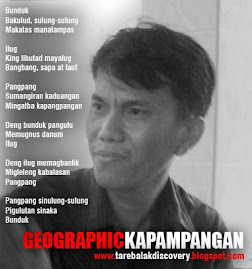Candido Sibal
(December 1,
1932 - April 19, 2016)
Educator, poet, essayist and a public intellectual
“Pagmaragul ke ing Indung Kapampangan! E makatauli king insanu man karing aliwang lalawigan king keyang panyulung king larangan ning bye moral, sosyal, king ekonomiya at magin king bye politika. Ing sangkan, atilu keti king Kapampangan ding memalen at mamuntukan a maka-Dyos, makabalen at maka-tau…” (Candido Sibal, Ing Amlat Ning Kapampangan, 1981)
Candido Sibal is a respectable educator and community servant leader. He is one of the pioneer teachers of Bamban, Tarlac during the difficult and challenging years of the 60s and 70s. Leading a few number of volunteer teachers, he served as the first principal of the then barrio elementary school of Malonzo, which is a very remote village of Bamban and later on assigned to other public schools of his town.
Idolized by many, he was considered a public intellectual by his town mates for he never runs out of wisdom to share especially for those who seek his sound advices and words of encouragement, and also to those who recognizes his dedicated teaching service.
Aside
from serving his town mates as an educator, Sibal also made his pen scribbled his
thoughts and wisdom in the shape of essays and poems. His “Ing Amlat Ning Kapampangan” (History of Pampanga) is a scholarly
work that combines his passion with Kapampangan literature and his knowledge
about local history. Indeed, this piece was able to win a second prize in the
1981-1982 annual essay contest sponsored by the Office of the Governor of Pampanga. Prior to this, he already won several
other essay writing competitions, one of them being the third prize in the 1980 Don Gonzalo Puyat Memorial Awards.
Sibals’
notable contemporary essayists include Serafin
D. Lacson, Felix B. Bautista, Eligio G. Lagman, Silvestre M. Punsalan, and Jose P. Fausto, who wrote from 1921 to
1941. His “Amlat” is among the more recent noteworthy essays together with “Ing
Pamilyang Cristiana” (The Christian Family) by Vicente B. Catacutan of Apalit, Pampanga; and “Ing Capampangan,
Napun, Ngeni, at Bukas” (The Pampango, Yesterday, Today, and Tomorrow) by Vedasto D. Ocampo of Magalang, Pampanga.
Most of these writers have been prizewinners in the annual literary contest
sponsored by the then Gov. Estelito
Mendoza of Pampanga. (JPM)
References:
Hilario-Lacson, Evangelina (1984). Kapampangan Writing, A Selected Compendium and Critique. Manila:
National Historical Institute
Icban-Castro, Rosalinda (1981). Literature of the Pampangos. Manila: University of the East
Mallari, Joel P. (2010). Kawatasan:
Obrang Poeta Laureado. Center for Kapampangan Studies-Holy Angel University
Manlapaz, Edna Zapanta (1981). Kapampangan
Literature, A Historical Survey and Anthology. Quezon City: Ateneo de
Manila University Press
v38.pdf Date
accessed: April 23, 2016
camaligcapampangan Date
accessed: April 23, 2016
Photo: Modified after a photograb from a facebook posting of Delfin
Sibal







